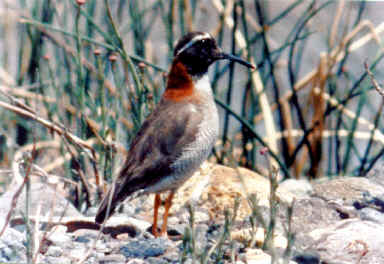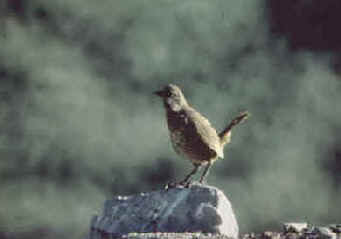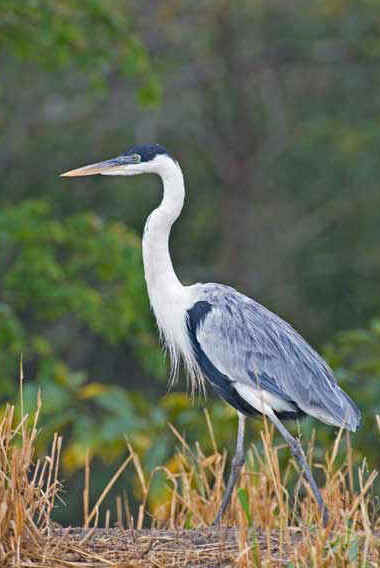
E-mail: font@focusonnature.com
Phone: Toll-free in USA 1-800-721-9986
or 302/529-1876; Fax: 302/529-1085
 |
PO
Box 9021, Wilmington, DE 19809, USA E-mail: font@focusonnature.com Phone: Toll-free in USA 1-800-721-9986 or 302/529-1876; Fax: 302/529-1085 |
THE FOCUS ON NATURE BIRDING & NATURE TOUR IN CHILE
November/December 2009
"With a special Plover, Parakeets, Penguins, & a Pudu"

The Diademed Plover
Links:
List of Birds & Other Wildlife during the FONT Chile Tour - November/December 2009
A
Complete List of the Birds of Chile (with
photos)
Mammals & Other Wildlife in Chile (with photos)
Upcoming FONT Birding & Nature Tours in Chile
The following narrative of the FONT Nov/Dec
'09
Chile Tour was
written by Armas Hill, the tour leader:
narrative to soon replace the following
As it nearly always is, the pelagic
trip offshore from Valparaiso that was part of our November
2007 FONT birding & nature tour in Chile,
was a highlight.
We were, as usual, out at sea for about 4 hours in the morning. During
that entire time, there were seabirds in view, including shearwaters,
petrels, giant-petrels, storm-petrels, pelicans, gulls, terns, boobies, and phalaropes.
The last of these, the Red Phalaropes, were not attracted to the
"chum" that brought most of the other birds in close to the boat, but
yet there were many phalaropes near us during the trip. We estimated well
over a thousand of them.
During that boat-trip, on November 23, 2007, the best of the seabirds were 2
Northern Royal Albatrosses. Both seen sitting on the water very close to us.
Those large albatrosses, so big, even seemed to dwarf the other 3
species of Albatrosses that, during the trip, were either on the water or
flying by us in the air: the Black-browed, the Buller's, and the Salvin's.
The wingspan of the Northern Royal Albatross is as much as 138 inches (that's
11.5 feet, or nearly 6 feet per wing!) Wow, what a bird to see as we did!
The plumages of the 2 individuals were a bit different; one was an adult, and
the other nearly so.
The wingspan of the Salvin's Albatross is 98 inches. That of the Black-browed
is 88 inches; the Buller's is 83 inches. So, these wingspans (of the
albatrosses also known as "Mollymawks") are
in the realm of 7 to 8 feet in length - that is each wing being from about 3.5
to 4 feet long.
Those albatross-wings enabled the birds to fly a long way. 3 of our 4 albatross
species flew from New Zealand breeding sites to the offshore Chilean waters
where we saw them. Our offshore trip was a couple hours out, and a couple hours
back to land.
It's 9.647 kilometers (one-way) from New Zealand to Chile. For those of
us who flew by jet from North America to Chile, as a comparison, it's 6,959
kilometers (one-way) from New York.
The 3 species of albatrosses that crossed the Pacific (the Northern
Royal, the Salvin's, and the Buller's) traveled
further to see us than we did to see them (referring to our flights in planes
from places such as Texas and Pennsylvania). And, yes, those albatrosses certainly
did see us too, as our "chum" was tossed from the boat, attracting the
oceanic birds by scent from miles around.
The Northern Royal Albatross, Diomedea sanfordi, is a rare
bird, with a total population of only about 7,000 pairs. As just noted, the
birds we saw came from New Zealand breeding sites.
Actually, New Zealand is the ONLY place where the Northern Royal Albatross
breeds, and in New Zealand, 99 per cent of the total breed ONLY on the Chatham
Islands.
In 1985, a severe storm hit the breeding sites on the Chatham Islands, reducing soil
cover and destroying all of the vegetation. Since then, nests there have been
built with stones, or eggs have been laid on bare rock. Unfortunately, as a
result, mean annual productivity has plummeted to 18 per cent of what it had
been, due to egg breakage, high temperatures, and flooding in temporary pools.
The species has been recently, and continues to be, monitored carefully.
We can only hope that things improve so that the wonderful sightings we've had
of the royal albatrosses off Chile continue in the years ahead.
Another scourge has been affecting albatrosses, overall, of various
species. Every year, during the last couple decades, thousands of albatrosses
have fallen victims to long-line fishing hooks, subsequently drowning. It's been
written that as many as 100,000 albatrosses have succumbed to this annually.
Naturally, without many predators, albatrosses live a long time - up to 60
years. But the impact of their decline during the last 20 years has notably
dramatic.
Of all the birds of the world now been categorized as threatened (and
unfortunately now there are many), the group in recent years with the
biggest increase of endangered and threatened species have been the seabirds.
FONT has been conducting pelagic trips off the Chilean coast of South America
since 1990. And, in general terms, our data has shown that the number of
albatrosses seen in those waters, since then, has decreased. There's some
variation due to factors such as "El Nino" & "La Nina"
waters, but, as said, in general, numbers in the last few years have been
lower than they were a decade ago.
There's a link following this narrative to the Birdlife International website,
relating to the recent decline in albatrosses & other seabirds due to
long-line fishing. It's worth taking a look.
Another comment worth making regarding birds we saw offshore (and along the
Chilean shore) is they come there from such a variety of places.
The cool waters of the Humboldt Current are
a draw not just for the albatrosses that come across the wide Pacific
from New Zealand, but for some other long-distance travelers as well.
The Red Phalaropes, that have been mentioned, come from the far-northern
reaches of the Northern Hemisphere where they nested.
The Sooty Shearwaters and Wilson's Storm Petrels came from further
south in the Pacific.
The Franklin's Gulls, that were numerous out over the salt water of the
Pacific came from fresh-water marshes and ponds in the interior of Canada and
the US. That species undergoes quite a transition in terms of seasonal habitat.
The Surfbirds, along the rocky seacoast, that we enjoyed so much watching
on the rocks, came from Alaska, where they nest high in the mountains far away
from the sea. Surfbirds, by the way, were not found to nest there until
well into the 20th century, in 1926.
During the portion our November '07 Chile Tour
on land, here was another wonderful encounter with a bird that's
"big". One of the biggest of American birds that soar in the sky, it
was the Andean Condor, with as a wingspan of up to 122 inches. That's
over 10 feet.
The Andean Mountains, that were such a
majestic backdrop as watched the condors, were also big.
But still, how impressive it was to see a dozen condors, fly by as if in
a procession between us and the mountain, one after the other, all gliding from
right to left. The grouping was a mix of adult and immature birds.
Another large bird, actually with "Giant" in its name, has
already been alluded to in this narrative. It's the Southern Giant Petrel,
with a wingspan of 81 inches (almost as long as that of the Buller's
Albatross - and almost as long as that of another of our
"biggies", the Peruvian Pelican which has wingspan of 90
inches).
And in the mountains, we saw another bird named "Giant". With a length
of up to 9 inches, it was the Giant Hummingbird, the largest of the
approximately 320 species in that family (which is, by the way, the second
largest of bird families in the Americas, and which contains, at the opposite
end of the spectrum from the Giant Hummingbird, a bird, in Cuba,
that's the smallest in the world).
During our November 2007 tour in central
Chile, we saw over 125 species of birds.
Mentioned here already have been just a few of those we saw.
Other highlights during our tour included:
Torrent Duck in a raging Andean river,
Humboldt Penguin, Gray Gull, and Inca Tern along the Chilean
seacoast,
Cocoi Heron (a species common other places in South America, but not so
in Chile),
and these:
Cinereous Harrier, Gray-breasted Seedsnipe, White-sided
Hillstar, Crag Chilia, Moustached Turca, Rufous-tailed Plantcutter, Many-colored
Rush Tyrant, and the Spectacled Tyrant.
We enjoyed very much our sighting of a male Torrent Duck, in the Andes
southeast of Santiago. The species ranges throughout much of that long range of
mountains. The subspecies in central Chile is the southernmost of 6.
Where we saw that subspecies in central Chile, is the northernmost part of its
range. There's a gap between that southernmost subspecies (the nominate), and
the other subspecies further north.
Torrent Ducks are confined to fast-flowing rivers and streams - in waters
so swift that one might think no duck, or any bird, could function there. But
they are truly marvelous swimmers and divers. Not only are they capable of
swimming against the fastest currents, but they can also remain surprisingly
stationary in such waters. In the midst of the raging torrents, they dive and
swim close to the bottom, to reappear on the steep side of the next rock or
boulder, and then they stand there as if oblivious to the rushing waters
swirling around them. Observing such behavior by the male we saw, we can only
watch and wonder how the bird does it!
Turning away from the fast-flowing river below us, to a cliff-face on the other
side of a dirt road, there was, above us, the Crag Chilia. That bird's
nifty name is quite appropriate as it's one that's endemic to Chile.
Superficially similar to a Canyon Wren (but without the wonderful song), the
bird is an inhabitant of crevices and crags on cliffs. We observed one
repeatedly taking food into a crevice for its young.
The Moustached Turca was another Chilean endemic bird that we enjoyed
watching. Sometimes it would be in a bush, but usually it was on the ground,
where it would rapidly run and then abruptly stop, with its short tail always
cocked.
The bird is in the tribe of tapaculos, a group well represented in Chile.
Among the tapaculos, the turca is generally the easiest to see.

Moustached Turca
Other birds on the ground, for us, at various elevations in the Andes, included:
California Quail, Gray-breasted Seedsnipe, South American Snipe, and Baird's
Sandpiper.
The California Quail was introduced in Chile over a hundred years ago, in
1870. Today, it's said that there are more California Quail in Chile than there
are in its native range. We saw many.
Gray-breasted Seedsnipe are nice birds to see. There are 4 species of
seedsnipes (a unique family), all of them in the Andes.
One of the Gray-breasted Seedsnipe sightings, during our November '07 tour, was
especially nice. A short distance away, on the ground, in front of a rock, there
was a fluffy little bird. In binoculars, it was seen to be a very young
seedsnipe. It stood still there for a while, before running into a cavity
beneath the rock.
The South American Snipe that we saw, on the ground, also stood very
still, by the edge of a little pond. We saw it outside the windows of our
vehicle. As we moved closer to the bird, it stayed there, remaining as still as
could be.
We backed the vehicle up a bit, and then drove away, before hearing a Dusky
Tapaculo call in the rocks in the background, as a pair of Speckled Teal was
at the far end of the pond.
On the opposite side of the road, where we stepped out of the vehicle, to enjoy
a look at a Crested Duck, there were, along a mountain stream, some Baird's
Sandpipers. They had come from North America, as we did, but for them it was
to spend another summer, in the Southern Hemisphere. The Baird's Sandpiper
is a common bird of the summer of the Southern Hemisphere in the High Andes.
Yet a couple more birds that we saw in the Andes should be mentioned.
The hummingbird, called the White-sided Hillstar, was good to see.
Of course, hummingbirds, anywhere, are good birds to see. But it's fascinating
how some species of hummingbirds live high in the Andes. The Hillstars that we
saw were at flowering plants by a "refugio", a place to stay and eat,
high in the mountains. Years ago (in the early 1990's) we stayed there
during our tours. It was good to visit the picturesque place again. And, it was
particularly good, as we saw the hummingbirds there on the grounds.
The Rufous-tailed Plantcutter is in a rather off-beat family of 3
species, related to cotingas.
Widespread in Chile, the plantcutter occurs from the sea up into mountains.
During previous tours, we've seen the bird in bushes by dunes along the
seacoast. For us, in Nov '07, however, it was as high as we've ever found it, up
in the Andes, at an elevation of over 8,000 feet above sea level.
Some birds that we saw in central Chile in November '07 were "new" for
us in that region of the country.
Among them, was the Cocoi Heron, at a marsh near Santiago.
During our previous Chile tours, we've seen the bird only in the southern part
of the country, north of the "Lake District".
In Nov '07, we saw a total of 4 at a place where we've birded many times in the
past. But the next day, when we visited the place again, the species was not to
be seen.
The Cocoi Heron is rather like the Great Blue Heron, but with a white
neck. It's larger than the Great Blue Heron. In fact, it's the largest of the
herons in the Americas.

Cocoi Heron
Another "new bird" for
us in central Chile was the Cinereous Harrier. We were fortunate to see a
fine, adult male, flying in front of us, above rolling fields.
And yet another bird "new" for us for central Chile, during this, our
17th tour there, was the Spectacled Tyrant, a flycatcher. We nicely saw
both males and females, at two locations. The male, all-black, with a bright
yellow eye-ring and bill, perches high up on reeds.
Within reeds, there was one of our favorite birds of the tour. It was another
flycatcher, a smaller one.
In English, its name is the Many-colored Rush Tyrant. In Spanish, it's
called "Siete Colores", meaningr "Seven
Colors". Even smaller than a House Wren, it's just as restless and
agile. It flits endlessly, always in a reedbed, from rush to rush. The bird half
jumps and half flies from reed to reed, and then balances itself on an
individual stem with consumate ease. The tiny, vivacious sprite that's forever
on the move, also continuously changes position in order to better show off its
multi-hued plumage that's a veritable symphony of black, bronze, green, yellow,
crimson, red, and white. (And, yes, that's seven colors.)
The Many-colored Rush Tyrant was one of the nicest birds we saw.
A couple birds we did not see during our November '07 tour
in central Chile, that we have in the past,
were the Diademed Plover and the South American Painted Snipe.
The Diademed Plover, a bird of the high Andes, has not been found in recent
years, at the single location near Santiago, that's been good for it in the
past. When we were at that place in Nov '07, it seemed as if too many people
were there, either in recreational vehicles, or camping at the particular place
that was known for the species since the 1950's.
The marsh, where the Painted Snipe has been for us previously, was, this year,
too dry.
So, we won't dwell on what wasn't there, but rather we'll remember the birds
that we did see, including the wonderful ones that have been mentioned here.
As noted, over 125 species of birds were seen during our tour in central Chile
in 2007. It was, as also mentioned, our 17th FONT tour in Chile. The first
FONT birding & nature tour anywhere was in Chile back in November of 1990.
Here's a last mention, now, regarding some of the birds of the tour:
As we were about to leave Santiago, and driving along the wide city boulevard,
with grass and trees in the middle of the busy street, there were Southern
Lapwings (even smack in the heart of the city, in front of the main
government building), and there were Austral Thrushes, one after the
other.
The Austral Thrush was very similar in its behavior to the American
Robin, commonly in the city and towns.
Also we have in North America, there were in central Chile: Mockingbirds,
Blackbirds, and Meadowlarks.
The Chilean Mockingbird is endemic to that country.
The Blackbird, like the Thrush, has the adjective "Austral".
The Long-tailed Meadowlark, quite unlike its North American counterpart,
has a bright red breast.
The House Sparrow was the same as ours (and the same as that of Europe).
In Chile, there are siskins rather than goldfinches. We saw both the Black-chinned
Siskin and the Yellow-rumped Siskin.
The only New World Sparrow is the Rufous-collared Sparrow (it occurs
north into Central America).
But in Chile, there's a wealth of finches:
we saw Yellow-finches (2 species), Sierra-Finches (a few
different species), and one finch with a rather odd name that's common, and
so it's called the Common Diuca Finch.
It was spring when we were in Chile, and thus the birds were singing.
That Common Diuca Finch had one of the nicest of the songs we heard,
providing yet another reason, among many, for us to enjoy our tour in Chile as
we did.